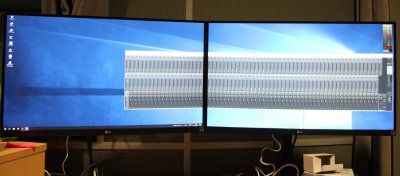Ja meinte das 24 AO. Denke mal bei Motu hängt das mit den Adat Ausgängen auch zusammen wegen 8er Mode?
RME
Network Latency (Presentation Time)
Allows setting of the delay of outgoing data. Available settings are 0.3125 ms, 0.625 ms, 1 ms and 2 ms. Similar to the ASIO buffer size, higher values are more reliable but cause additional latency. However, unlike ASIO low values do not lead to crackling, but to a complete failure of the audio stream.
20.2 AVB Network Latency
All devices in an AVB network share the same time. This allows the sending device (talker) to
specify the precise point of time when its audio samples should be played out at the receiver
side (listener). This is achieved by adding an offset to the cu
rrent time and sending the resulting timestamp with each sample transmitted. The timestamp is called
"presentation time" and has nanosecond precision. For comparison, a single sample at 48 kHz
has a duration of over 20800 ns.
The receiver compares the incoming presentation time of each sample to the current time and
buffers the sample until the presentation time is has come. The offset (maximum transit time) is
specified by the AVB standard as 2 ms for class A traffic, which is enough time for the signal to
pass through a very large network under full load with up to seven 100 MBit/s switches along
the way. By default, most AVB products will use this offset. In smaller networks with less hops
or 1 GBit/s link speed, the offset can be adjusted to lower values, such as 0.3 ms, 0.6 ms or 1 ms. In the event that the chosen offset is too low, the listener detects that the requested presentation time has already passed
and the audio data is discarded.The Digiface AVB acts both as a talker with an adjustable offse
t of 2 ms down to 0.3 ms, and as a listener - where the latency depends on the talker.
In AVB networks, the latency is always specified by the talker and guaranteed by the listener -
with nanosecond accuracy. This behavior is plug & play and does not require any user interac-
tion or monitoring. Due to the large number of possible listeners and talkers in a
network, it is usually not possible under AVB to speak of typical network latency. Rather, dependin
g on the configuration of the individual devices, their current presentation time, and the us
ually not included AD/DA conversion delay, a large number of possible latencies occur, d
epending on which device communicates with which one and where the data is fed in and out.
Due to the specification of a maximum presentation time of 2 ms, however, including AD/DA
conversion, a maximum value of 5 ms can be assumed. With a setting of 0.625 ms and current
low latency converters 1.5 ms can be reached, for the complete path Analog In -> Network ->
Analog Out
http://www.rme-audio.de/download/dface_avb_e.pdf

